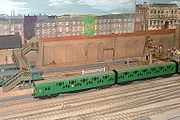
SR Class 4DD
Encyclopedia

Oliver Bulleid
Oliver Vaughan Snell Bulleid was a British railway and mechanical engineer best known as the Chief Mechanical Engineer of the Southern Railway between 1937 and the 1948 nationalisation, developing many well-known locomotives.- Early life and Great Northern Railway :He was born in Invercargill,...
for the Southern Railway
Southern Railway (Great Britain)
The Southern Railway was a British railway company established in the 1923 Grouping. It linked London with the Channel ports, South West England, South coast resorts and Kent...
's Dartford
Dartford
Dartford is the principal town in the borough of Dartford. It is situated in the northwest corner of Kent, England, east south-east of central London....
commuter route, the two 4DD electric multiple unit
Electric multiple unit
An electric multiple unit or EMU is a multiple unit train consisting of self-propelled carriages, using electricity as the motive power. An EMU requires no separate locomotive, as electric traction motors are incorporated within one or a number of the carriages...
s were the only double-deck train
Bilevel car
The bilevel car or double-decker coach is a type of rail car that has two levels of passenger accommodation, as opposed to one, increasing passenger capacity ....
s to run on the main line railway network in Britain. Whilst common in Europe and North America the restrictive railway loading gauge
Loading gauge
A loading gauge defines the maximum height and width for railway vehicles and their loads to ensure safe passage through bridges, tunnels and other structures...
in the United Kingdom prohibits normal double-deck cars with two fully separated decks. On the 4DD carriages the upper-level seats were squeezed in between the lower-level seats to ensure that the overall height of the unit was within the clearances necessary to pass through tunnels and under bridges. The 4DD was somewhat unsuccessful because the upper level compartments were cramped and poorly ventilated (the upper level windows could not be opened due to tight clearance). The compartments were pressure-ventilated but the equipment proved to be troublesome. Dwell times at stations were lengthened because of the increase in the number of passengers per door. To obtain the extra seating capacity
Seating capacity
Seating capacity refers to the number of people who can be seated in a specific space, both in terms of the physical space available, and in terms of limitations set by law. Seating capacity can be used in the description of anything ranging from an automobile that seats two to a stadium that seats...
that was being sought, it was instead decided to lengthen trains from eight cars to ten.
Unusually for an "experiment" they lasted in traffic from 1949 to 1971, undergoing routine maintenance and repaints with no hiccups in their life.
Formations
| Unit Numbers | TT | DMBT | Notes | ||
|---|---|---|---|---|---|
| 4001 (later 4901) | 13001 | 13501 | 13502 | 13002 | (built September 1949) |
| 4002 (later 4902) | 13003 | 13503 | 13504 | 13004 | (built October 1949) |
Preservation
Driving motor cars 13003 and 13004 survive, the former at Kent Locomotives Ltd - Sellinge, Kent, and the latter at the Northamptonshire Ironstone Railway TrustNorthamptonshire Ironstone Railway Trust
The Northamptonshire Ironstone Railway Trust operates a mile long heritage railway line at Hunsbury Hill, south-west of Northampton. The line is mainly dedicated to freight working, featuring many sharp curves and steep gradients which were typical of the industrial railway, but rides are...
. One trailer was also saved, but has since been scrapped.

